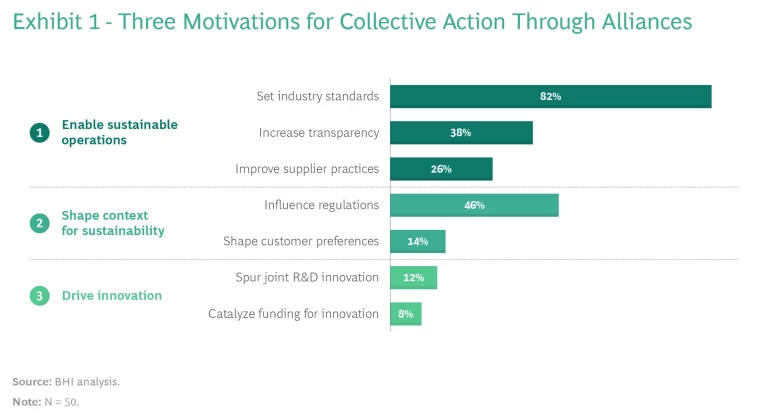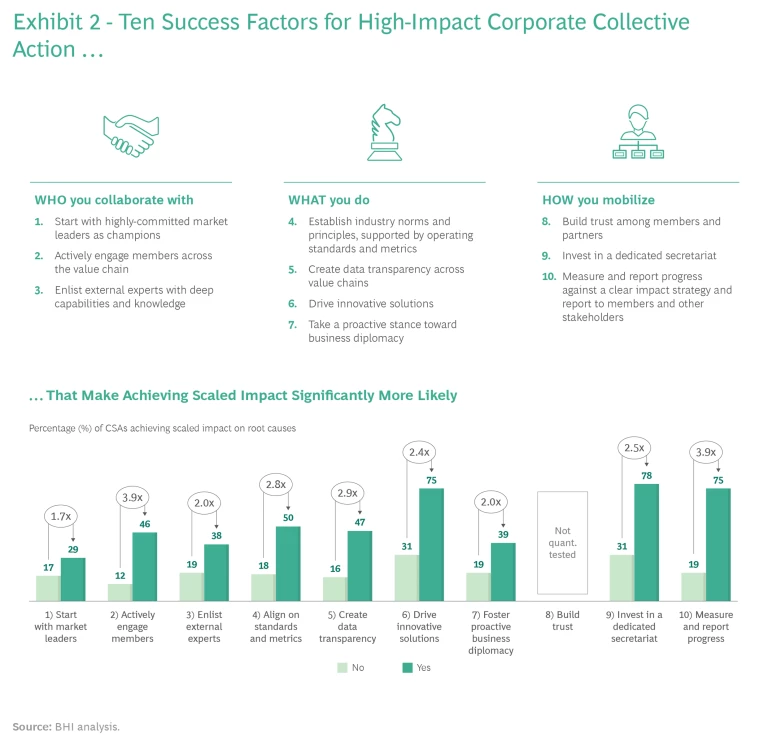Corporate-led sustainability alliances can be a secret weapon in the drive to create system-level change. We discovered ten factors that separate high-impact CSAs from the rest.
Companies are setting more ambitious climate and sustainability goals than ever before—but many are finding that sustainability cannot be achieved singlehandedly. This is partly because, for many companies and products, 90% or more of greenhouse gas emissions are outside their direct control.
To achieve sustainability across the entire value chain, companies must act aggressively—and collectively—to transform their ecosystems. Three forms of collaboration can be used to achieve sustainability goals. Companies can forge partnerships to advance a specific sustainability-related product, service, or initiative. They can participate in or orchestrate a broader sustainability business ecosystem; that is, a dynamic group of independent businesses that together constitute a coherent solution to address a specific sustainability need in the market. Or they can participate in a corporate-led sustainability alliance. (See “Three Models for Collaboration.”)
Three Models for Collaboration
Sustainability Partnerships. Partnerships are contractual relationships typically established along a single company’s value chain to deliver on its unique business and sustainability goals. This type of collaboration tends to be a one-to-many relationship; that is, a central company coordinates with a set of sustainability partners. For example, in 2020, organic cotton production represented only 1% of global cotton production. Primark, a fast fashion company, collaborated with CottonConnect to shift smallholder farmers to more sustainable practices and with Oritain to forensically trace and validate the cotton. These partnerships have enabled Primark to break the constraints of its ecosystem and access scarce supply for products merchandised under its “Primark Cares” label.
Sustainability Business Ecosystems. Business ecosystems are a form of collective action wherein a dynamic group of independent businesses creates products or services that together constitute a coherent solution to a marketplace or consumer need. Monetary value exchange is explicitly built into the design of the business ecosystem to align the incentives of actors, and while there may be an orchestrator, business ecosystems are rarely hierarchical. BIMA, a health and insurance provider, uses mobile technology to bring vital health and insurance products to more than 35 million customers in parts of Asia and Africa. BIMA’s platform delivers societal value by integrating telco providers, mobile money providers, and insurance underwriters to provide a seamless, user-friendly experience for its users.
Corporate-led Sustainability Alliances. These alliances are a form of multistakeholder collective action that focus on setting industry standards and increasing data transparency across value chains, influencing regulation and shaping customer preferences, or supporting innovation through joint R&D and catalyzing capital. What distinguishes CSAs from other forms of sustainability alliances is that businesses and their priorities are the driving force behind the alliance, shaping the collective agenda to enable businesses to transition to more sustainable practices in a way that is economically viable. Corporate-led sustainability alliances operating today include One Planet Business for Biodiversity, which focuses on cultivating and restoring biodiversity; the Global Platform for Sustainable Natural Rubber, which aims to make the natural rubber value chain fair, equitable, and environmentally sound; and the Consumer Goods Forum, which focuses on addressing such issues as environmental sustainability and the opportunity to develop products that contribute to global health and well-being.
Although partnerships and business ecosystems are important collaboration models, they are too limited in scope for many industries’ most deeply entrenched sustainability challenges, particularly those in hard-to-abate sectors. In many cases, what’s needed is option number three: a corporate-led sustainability alliance (CSA): a multistakeholder, business-led coalition designed to advance the sustainability of its members and their industries for the common good.
Consider a typical mining company. More than 90% of its CO2 emissions are so-called Scope 3 emissions, occurring downstream. Steel production from iron ore produces significantly more emissions than the mining process itself. To decarbonize steel making, therefore, mining companies, steel makers, technology providers, suppliers of novel raw materials (such as hydrogen), research institutes, and end users (such as automotive original equipment manufacturers) must work together to decarbonize the whole value chain.
Consider a typical mining company. More than 90% of its CO2 emissions are so-called Scope 3 emissions, occurring downstream.
How do companies build a high-impact corporate-led sustainability alliance? The BGC Henderson Institute studied more than 50 CSAs across multiple industries, geographies, and sustainability challenges to understand what makes some highly successful while others underperformed. The most effective alliances excelled in multiple ways: they understood whom to collaborate with, what was needed to accelerate progress, and how to mobilize collective action. Based on our research, we identified ten key success factors for building a high-impact corporate-led sustainability alliance.
The Alliance Advantage
Compared with partnerships and business ecosystems, corporate-led sustainability alliances can bring together a much broader range of stakeholders: not just businesses and suppliers, but also regulators, policymakers, the social sector, customers, competitors, academics, and researchers. Led by corporations, they galvanize stakeholders to address the most complex sustainability challenges—societal or environmental—that also have significant implications for their businesses. We see three primary motivations for companies engaging in collective action through alliances. (See Exhibit 1.)
- Alliances enable more sustainable operations by setting industry standards, increasing data transparency across value chains, and improving supplier practices.
- They allow companies to shape the sustainability landscape by collectively influencing regulation and shaping customer preferences.
- They drive innovation by spurring joint research and development and mobilizing capital investments around emerging solutions to shared sustainability challenges.
Compared with partnerships and business ecosystems, corporate-led sustainability alliances can bring together a much broader range of stakeholders.
To build a high-impact alliance, companies must collaborate with the right stakeholders, drive the process forward effectively, and mobilize action that delivers meaningful benefits by targeting root causes of the environmental or societal issue. The frontrunners are doing just that by taking ten crucial actions.
Ten Factors for Success
Whether companies are carefully constructing a portfolio of alliances to achieve sustainability goals, or they’re already engaging in existing alliances, it’s critical that they maximize their return on investment.
Of those alliances that have a real impact, half are more than 15 years old.
In our study of more than 50 corporate-led sustainability alliances, approximately 30% were able to address root causes to deliver at-scale social and environmental benefits. The remaining 70% were either focused on mitigating negative societal and environmental impacts without addressing root causes or targeting root causes but not yet able to scale their initiatives. And of those alliances that have a real impact, half are more than 15 years old—demonstrating that it takes time for an alliance to become a truly effective vehicle for collective action.
Our analysis of CSA leaders versus the laggards pointed to ten key actions that helped them outperform their peers—and that we group under three umbrellas: who, what, and how. (See Exhibit 2.)
Think strategically about who you collaborate with
It’s important for companies to think carefully about the types of organizations that should be included in the alliance and what value they bring. While a corporate-led sustainability alliance will always be led by business priorities, it should include a variety of stakeholders, including suppliers, regulators, policymakers, nongovernmental organizations (NGOs), customers, competitors, academics, and independent experts. Specifically, high-impact alliances adhere to the following actions.
1. Start with highly committed market leaders as champions. Corporate-led sustainability alliances founded by a group of market leaders (at least two members of the Fortune Global 500) were 1.7 times more likely to achieve impact at scale. Market leaders have sufficient scale and market power to credibly signal to the broader ecosystem the level of commitment to change and materially shift the incentives of stakeholders outside the alliance. This is particularly important for alliances focused on sustainability issues that span multiple industries, such as ending deforestation.
In 2002, Danone, Nestlé, and Unilever created what would become the Sustainable Agriculture Initiative Platform as a precompetitive space for collaboration and knowledge sharing in the food and drink industry. Today it has more than 150 members, including farmer co-ops, manufacturers, processors, and retailers, working together to advance sustainable agriculture practices and pilot innovative projects.
2. Actively engage members across the value chain. Corporate-led sustainability alliances that include a broad set of value chain participants—and that ensure members across the value chain are represented and engaged in decision-making forums, such as boards and executive committees—are four times more likely to achieve impact at scale. Inclusive and engaged membership ensures greater buy-in to the alliance’s activities, which is particularly important for alliances that need to change standard ways of operating up and down the industry’s value chain. It’s important to prioritize the value chain segments that have the greatest role to play in addressing shared sustainability challenges.
Inclusive and engaged membership ensures greater buy-in to the alliance’s activities, which is particularly important for alliances that need to change standard ways of operating up and down the industry’s value chain.
For example, the Initiative for Responsible Mining Assurance (IRMA) set a comprehensive global standard that covers all mined materials (except energy fuels) for industrial mines around the world. It is governed equitably by a wide variety of stakeholders, including the mining industry, downstream purchasers, finance and investors, NGOs, affected communities, and organized labor—all of which have equal board representation and equal decision-making authority (so that the interests of any one given stakeholder group cannot override IRMA’s members’ collective interests). This was critical given IRMA’s primary focus on creating a global standard that required buy-in from across the value chain to ensure adoption and drive critical mass. As an example of the growing impact of IRMA’s “Standard for Responsible Mining,” several leading auto companies, including Mercedes-Benz, committed their intention to source lithium and cobalt for battery cells only from IRMA-audited mining sites in the future.
3. Enlist external expertise. Corporate-led sustainability alliances that engage cross-sector partners with deep expertise, such as academic researchers and third-party certification organizations, to support key activities of the alliance were two times more likely to create impact at scale. These experts serve as accountability partners and provide external legitimacy. This is particularly important for alliances that undertake joint research projects, ensure verification of supply chain programs, or enable data sharing.
The Tire Industry Project (TIP), which covers more than 60% of the world's tire manufacturing capacity, is a global forum for the tire industry on sustainability issues. TIP coordinates a global team of industry experts and scientists to ensure its projects maintain a high level of scientific integrity, quality, and accountability. This research group, led by an industry board—with guidance from an assurance group of independent scientists—helps objectively focus the alliance’s research agenda toward the highest impact topic areas in the industry and helps build greater alignment across members.
Focus alliance on activities that drive impact
BCG Henderson Institute research found that high-impact corporate-led sustainability alliances are action-oriented, transparent with data, focused on innovative solutions, and willing to engage with regulators and government leaders to shape the sustainability agenda. Specifically:
4. Establish industry norms and principles. Alliances that create alignment around robust operating standards, supported by detailed metrics and reporting protocols, are 2.7 times more likely to create impact at scale. It’s not enough to establish high-level guiding principles; they must be translated into clear product or operating standards, supported by measurement methodologies and regular progress reports.
It’s not enough to establish high-level guiding principles; they must be translated into clear product or operating standards, supported by measurement methodologies and regular progress reports.
The Poseidon Principles, an initiative of the Global Maritime Forum, established a common, global framework to quantitatively assess and disclose whether signatory financial institutions’ marine lending portfolios are aligned with UN climate goals. This framework translates high-level principles into a clear accountability mechanism to ensure lending decisions promote international shipping’s decarbonization.
5. Create data transparency. Alliances that create data transparency for members, as well as external stakeholders, are three times more likely to create impact at scale. Data transparency allows alliance members to monitor their progress toward sustainability targets and build a culture of accountability. This involves fostering alignment on the most important metrics, establishing strict data definitions, and developing tools and platforms to seamlessly collect data from stakeholders.
The Sustainable Apparel Coalition, a global, multistakeholder alliance for the fashion industry, collaborated with more than 250 global members and stakeholders to develop and launch the Higg Index—a core suite of tools to measure and assess sustainability performance in a standardized way. The Higg Index allows companies to assess the social and environmental performance of their value chain and publicly disclose the environmental impacts of their products to consumers in a comprehensive and credible way. The user base includes more than 21,000 organizations across 119 countries, with membership covering approximately 40% of the apparel, footwear, and home textiles industry.
6. Drive innovative solutions. Corporate-led sustainability alliances that drive innovation by participating in collaborative R&D and directing capital towards sustainability solutions are 2.5 times more likely to have significant potential to create impact at scale. This is especially important for alliances in hard-to-abate sectors since they typically require substantial technical innovation to achieve climate goals. Alliances should take a portfolio approach to ensure innovation focuses on near-term and long-term sustainability solutions. From the outset, the organization will need to rigorously ensure members’ intellectual property is appropriately protected. When mobilizing capital, alliances should seek out broader support beyond just financial contributions to leverage members’ capabilities, such as mentorship, expert advisors, access to labs and facilities, and pilot opportunities.
Alliances should take a portfolio approach to ensure innovation focuses on near-term and long-term sustainability solutions.
The Oil & Gas Climate Initiative (OGCI) launched a $1 billion innovation fund investing in technologies and projects that accelerate decarbonization across the energy, industrial, commercial buildings, and transport sectors. OGCI members support commercial adoption by launching pilots and investing in promising new technologies. OGCI Climate Investments has made 24 climate investments to reduce methane emissions, reduce carbon dioxide emissions, and support carbon capture, utilization, and storage solutions.
7. Take a proactive stance toward business diplomacy. Corporate-led sustainability alliances that proactively shape the regulatory and policy environment for greater sustainability and business advantage are 2.1 times more likely to create impact at scale. This is particularly true when members can’t reach their climate goals without public sector investment and greater regulatory certainty.
In 2021, the Global Maritime Forum called on governments to establish the necessary policies and investments to decarbonize international shipping by 2050. More than 230 signatories urged governments to support industrial-scale, zero-emissions shipping projects and deliver policy measures that will make zero-emissions shipping the default choice by 2030.
Understand how to mobilize collective action
The most successful corporate-led sustainability alliances put the right elements in place to foster collaboration and get results. They build a culture of trust, dedicate resources to a secretariat, and continually monitor progress against their impact strategy. Specifically:
8. Build trust. High-impact alliances spend meaningful time up front establishing a culture of trust among members, as well as with external partners. This can best be achieved by developing a set of shared values, finding ways to create mutual benefit for all participants, and ensuring that leaders of the alliance proactively address any emerging issues. The most influential members of the alliance must demonstrate early on that they are clearly aligned and fully committed to the mission. As trust continues to rise over time, the alliance requires lower levels of orchestration. Each participant influences and is affected by the others, creating an increasingly strong alliance that can sustain itself in the long run.
The most influential members of the alliance must demonstrate early on that they are clearly aligned and fully committed to the mission.
9. Create a dedicated secretariat. Corporate-led sustainability alliances led by dedicated secretariats staffed by professional teams with the strategic capabilities to deliver are 2.5 times more likely to achieve impact at scale. The secretariat should facilitate the alliance's activities and will require specialized skills, particularly with regard to driving innovation, establishing industry standards, and improving suppliers’ sustainability practices.
The Roundtable on Sustainable Biomaterials (RSB) has a lean secretariat with staff who oversee the development, promotion, and implementation of the RSB standard. Staff members are aligned to specific sectors across aviation, energy, ground transport, chemicals and polymers, and textiles and fibers, with deep expertise in their specific sectors.
10. Measure and report progress against a clear impact strategy. Corporate-led sustainability alliances that have a comprehensive impact strategy (also known as a theory of change) and continually track progress toward achieving long-term outcomes are four times more likely to create impact at scale. An impact strategy allows alliances to align members on key priorities, routinely test and measure progress toward goals, and demonstrate value to members and external stakeholders.
The Roundtable on Responsible Soy is developing a detailed impact strategy around six long-term objectives, accompanied by short-term and mid-term compliance indicators for soy companies.
The Roundtable on Responsible Soy is developing a detailed impact strategy around six long-term objectives, accompanied by short-term and mid-term compliance indicators for soy companies. The indicators focus on core environmental and social issues, such as soil conservation, biodiversity, work safety, and human rights, allowing the alliance to track impact and report progress to members and external stakeholders.
Today’s sustainability challenges require collective action to bring about system-level change. Corporate-led sustainability alliances are becoming increasingly common, particularly in hard-to-abate sectors, as companies recognize that there’s a limit to how much progress they can make within the walls of their own organization.
As companies embark on their sustainability transformation, they need to understand how to get the most out of existing alliances—and recognize when it’s time to join or create new alliances. By applying the ten success factors we’ve just described, companies can engage collective action to improve the common good and unlock new sources of competitive advantage.









